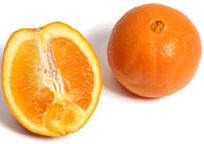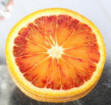|
Your online resource for all things culinary |
|
|||||||||
|
||||||||||
|
||||||||||
| Â | ||||||||||
 Â
copyright:: www.fotolio.com  Origin and History of OrangesÂ
There are two main types of oranges: Sweet and Bitter. Citrus
aurantium the bitter orange, originated in China where it was well documented in
writings by 300BC and by 100BC bitter orange seeds had made their way to Europe.
The sweet orange, Citrus sinensis, is also believed to have originated in South
East Asia (India, China and Indo-China). They had certainly been cultivated in
China for centuries although the name "orange" comes from the Sanskrit word "
narangah " which means fragrant. Types of Oranges and Cultivation of OrangesÂ
Of the
bitter varieties, Seville oranges are possibly the best known and most widely
available. These are not really suitable for eating raw and are often used in
the making of preserves, in particular marmalade. Â
|
|
|||||||||
|
Orange trees grow to 7 metres/22 feet in commercial orchards although they can be larger if not pruned. Even though orange trees will often come true from seed, as it takes between 8 and 15 years for the tree to start bearing fruit, the most common practise for commercial growers is by budding or grafting onto desirable rootstocks, which start bearing fruit within three years. Most cultivated varieties are self-pollinating however. Commercially, much of the harvesting is still done manually by hand. Once the fruit have been picked they sent to packing houses where they are washed and graded before being shipped for market.  Because most of the fruit you buy has come from budded or grafted trees as described above, their seed will probably not produce fruit of the same quality. Therefore if you want to grow oranges at home it�s best to buy citrus plants and only grow oranges from seed for ornamental purposes. Orange plants cannot tolerate frosts so unless you life in a frost free area, they will have to be grown indoors preferably in a conservatory or greenhouse.  Buying and Storing Oranges Select fruit which are firm, well-coloured and feel heavy. Store oranges at room temperature to keep them at their juiciest. They should keep well for close to two weeks. Alternatively, store unwrapped in the refrigerator. When buying navel oranges, select those with small sized navels as larger navels indicate that they were overripe when picked.  Oranges in Cooking Oranges are a versatile fruit which can be incorporated into sweet and savoury dishes. The favour goes well with cinnamon, mint, chocolate and almonds as well as many fish, meats and poultry. Al parts of the orange are used in cooking: the juice, flesh and rind, all together or separately.  When using the rind, try to pare it thinly to avoid incorporating the white pith which can sometimes give a slightly bitter taste.  When juicing oranges, more juice can be extracted if the oranges are at room temperature. If they are cold, pierce the skins with a fork in several places then place in the microwave for 20-30 seconds. Alternatively, place in a bowl of boiling water for 30 seconds.    |
||||||||||
Â
|
||||||||||
| Â | ||||||||||

 Oranges
belong to the Citrus family which includes other fruit such as lemons,
grapefruit, tangerines, mandarins and kumquats. They are popular in many parts
of the world both for eating and as an ingredient in recipes, with all parts of
the fruit being used in various ways.
Oranges
belong to the Citrus family which includes other fruit such as lemons,
grapefruit, tangerines, mandarins and kumquats. They are popular in many parts
of the world both for eating and as an ingredient in recipes, with all parts of
the fruit being used in various ways.
